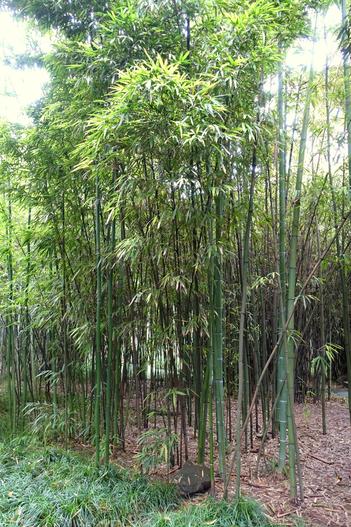Moso Bamboo
(Phyllostachys iridescens)
Moso Bamboo (Phyllostachys iridescens)
/
/

Daderot
CC0
Image By:
Daderot
Recorded By:
Copyright:
CC0
Copyright Notice:
Photo by: Daderot | License Type: CC0 | License URL: http://creativecommons.org/publicdomain/zero/1.0/deed.en | Uploader: Daderot | Publisher: Wikipedia Commons

Estimated Native Range
Summary
Phyllostachys iridescens, commonly known as Moso bamboo, is a fast-growing evergreen bamboo native to the subtropical forests of Anhui, Jiangsu, and Zhejiang provinces in China. It can reach heights of up to 72 feet (22 meters) with culms (stems) that are typically 4-7 inches (10-18 cm) in diameter. Moso bamboo has a distinct appearance with straight, tall culms and lush green foliage. It is known for its striking presence and is often used as a focal point in gardens and landscapes.
Moso bamboo is valued for its rapid growth and the visual impact of its dense, tall stands. It is used for screening, as a windbreak, and for its ornamental qualities. In cultivation, it requires ample space to accommodate its spreading habit and prefers full sun to part shade. It thrives in well-drained soil with regular watering. While it is a popular choice for creating natural barriers, it is important to manage its spread, as it can become invasive outside its native range. Its aggressive root system can cause problems if not contained, and it may outcompete native vegetation.CC BY-SA 4.0
Moso bamboo is valued for its rapid growth and the visual impact of its dense, tall stands. It is used for screening, as a windbreak, and for its ornamental qualities. In cultivation, it requires ample space to accommodate its spreading habit and prefers full sun to part shade. It thrives in well-drained soil with regular watering. While it is a popular choice for creating natural barriers, it is important to manage its spread, as it can become invasive outside its native range. Its aggressive root system can cause problems if not contained, and it may outcompete native vegetation.CC BY-SA 4.0
Plant Description
- Plant Type: Grass
- Height: 10-30 feet
- Width: 5-10 feet
- Growth Rate: Rapid
- Flower Color: N/A
- Flowering Season: Non-Flowering
- Leaf Retention: Evergreen
Growth Requirements
- Sun: Full Sun, Part Shade
- Water: Medium
- Drainage: Medium, Fast
Common Uses
Border Plant, Drought Tolerant
Natural Habitat
Native to subtropical forests in Anhui, Jiangsu, and Zhejiang provinces in China
Other Names
Common Names: Phyllostachys iridescens, Hong Bu Ji Zhu, Iridescent Bamboo
Scientific Names: , Phyllostachys iridescens, Phyllostachys iridescens f. luteosulcata, Phyllostachys iridescens f. luteosulcata, Phyllostachys iridescens f. striata,
GBIF Accepted Name: